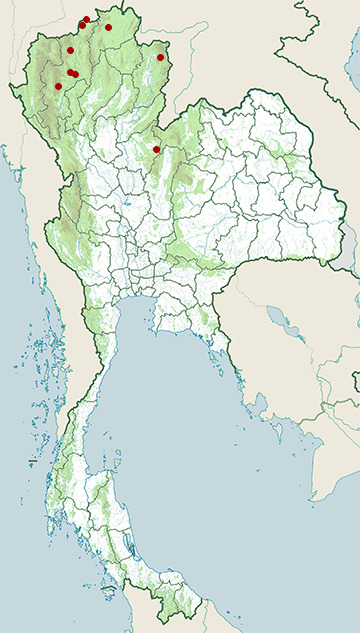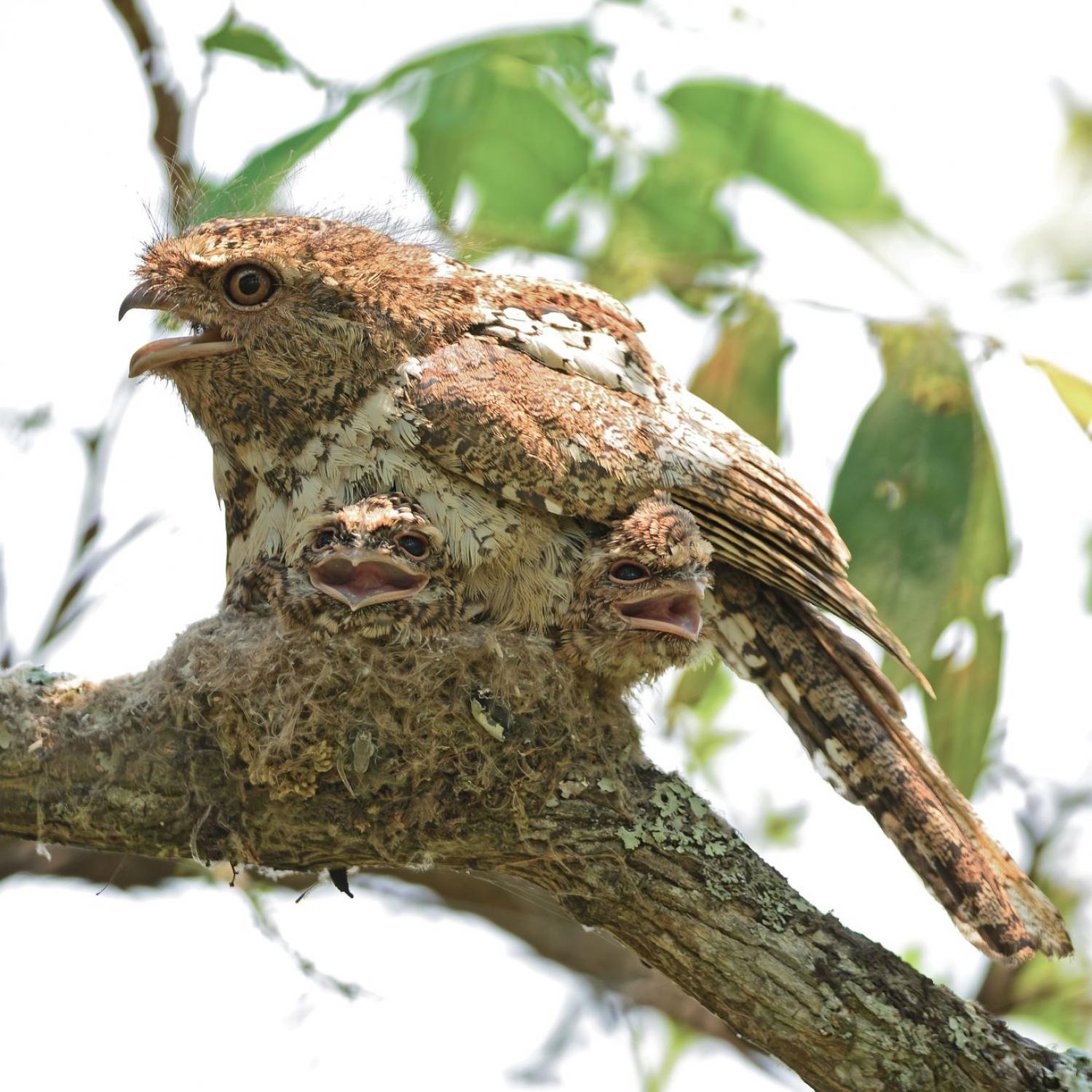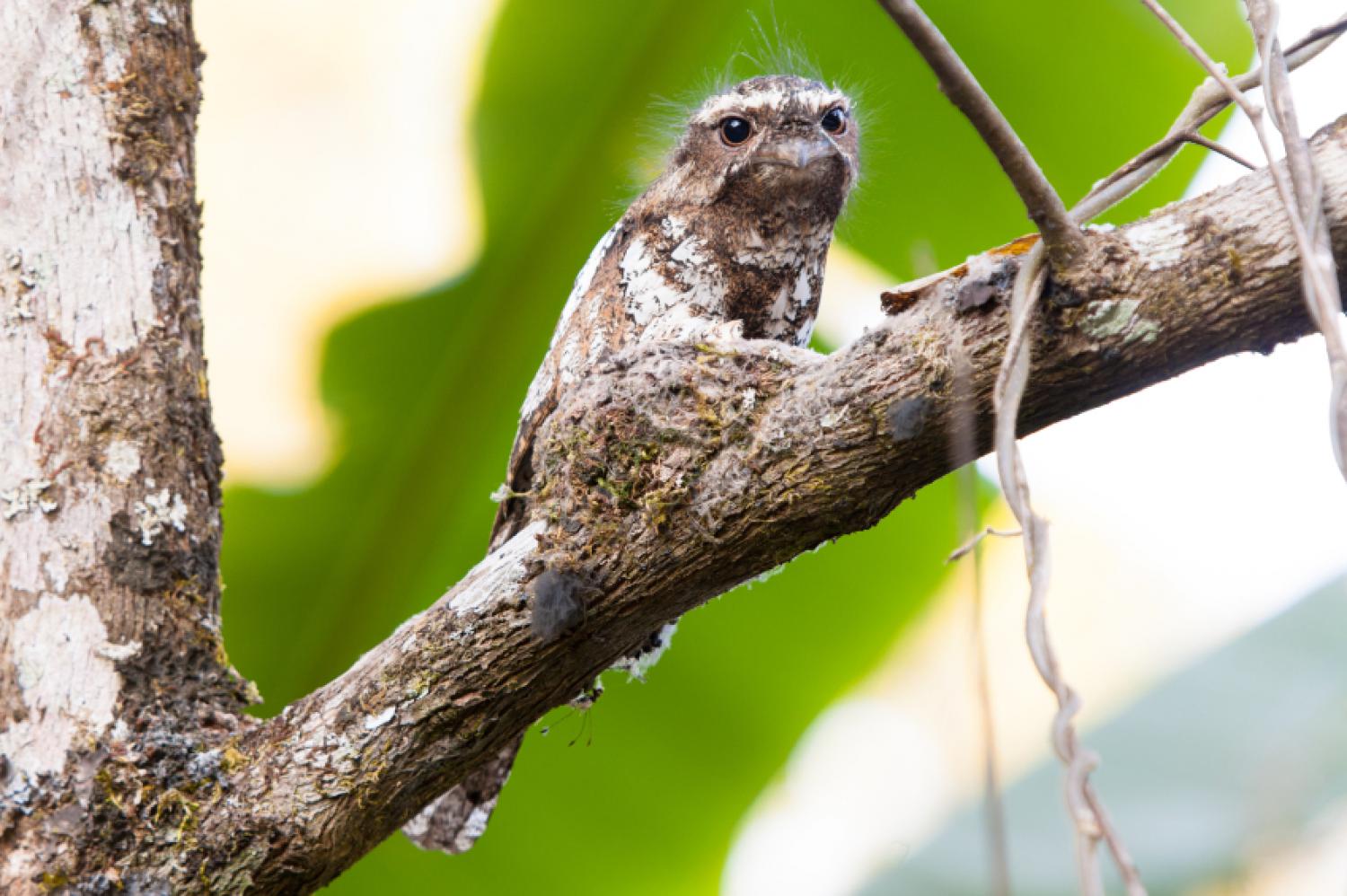Species of Thailand
Hodgson's frogmouth
Batrachostomus hodgsoni
John Edward Gray, 1859
In Thai: นกปากกบลายดำ
Hodgson's frogmouth (Batrachostomus hodgsoni) is a species of bird in the family Podargidae. It is found in Bangladesh, Bhutan, China, India, Laos, Myanmar, Thailand, and Vietnam. Its natural habitat is temperate forests.
The common name commemorates the British naturalist Brian Houghton Hodgson.
This bird is part of the same order as nightjars are. Both birds are nocturnal and they share similar rictal bristles on the bill which they use to know when to close their bill shut on insects as they hawk. This feature is just a hypothesis by scientists who do not completely understand the true use of those bristles yet. the frogmouth differs from its cousin by heavier bills, shorter and more rounded wings and upright posture when perched.
Description
Hodgson's frogmouth is one of the smaller members of the family Podargidae. As an adult, its length ranges between 24.5 and 27.5 cm and it weighs approximately 50 g. The brown and gray plumage of this tropical bird resembles tree bark. This plumage is a soft and mottled cryptic plumage. The physical appearance differs from other species by a heavier black marking above breast as well as no rufous on breast. Hodgson's frogmouth is the most well-marked sexual dichromatic of all frogmouths. The male is rufous brown. Upper parts are heavily marked with black, especially on the head, with irregular bold whitish markings particularly on scapular and upper mantle which forms a white collar. Underparts are heavily and regularly marked with black, white and rufous. Female is more uniformly rufous, with irregular black-tipped white spots on the upper mantle, scapular and underparts. Males duller in color than females. Frogmouths are distinguishable by their large head and body compared to their small legs and feet. This feature blocks them from walking and make them exclusively arboreal. They have a thick large bill that takes the most part of their face and make them look like an angry old man. This strong bill is covered with rictal bristles at its base. These two last physical traits are others unique criteria of Frogmouth that make them look like an angry old man. The utility of the bristles on their face is much debated by biologists. The most popular hypothesis is that the bird would use them to detect insects and know when to close their bill shut on the invertebrates when this one is near the mouth. They have additional long facial bristles suspected to protect the eyes. Their large head and their bill also contain a pair of two large yellow-rounded eyes which help them to see in the dark during night times. The Asian bird possesses short round wings and tail which explain its very local territory. As they do not differ from other frogmouth except some slight color variation, the best way to identify Hodgson's frogmouth is by its call.
Youngs are born with white down that is replaced by a darker, grayish down before juvenile plumage is acquired. They also have warm-tinged above with black and pale brown bars. They do not possess nuchal collar which only comes after primary molt.
Taxonomy
The Hodgson's frogmouth is part of the genus Batrachostomus within the family Podargidae. This family contains 12 species separated into two genera: Podargus (9 species) and Batrachostomus (3 species). The two genus differ by their size and their geographical location. Podargus are the taller individuals going up to 60 cm in heights which is twice the size of the Batrachostomus individuals.
There are two recognized subspecies of Hodgson's frogmouth:
- B. H. hodgsoni - living in Myanmar, India and Bangladesh.
- B. H. indochinae - living in Indonesia, Thailand and Laos.
Distribution habitat
The species arboreal is an adept of broad leaves evergreen or mixed coniferous tropical rain forests inside of which it will be found mainly on the middle and lower storeys. It is found in tropical regions of Asia at altitudes ranging from 300 – 1900 m. The Podargidae is a non-migratory bird family as well as solitary individuals, the only social interaction happens during the breeding season where the individuals all converge in the Indian region between the month of April and June.
The home range of the Hodgson's frogmouth consists of all tropical regions of Asia. Those region corresponds to the South of Asia, this is why it has been heard or seen in Sri Lanka, SE Asia, Indonesia, E Himalayas, NE India, Bangladesh, Laos, W, N, E Myanmar, NW Thailand, Laos, and C Annam. The first Hodgson's frogmouth in central Laos was recorded in 1994 during the month of April in a dry evergreen forest at 1000 m of altitude. The two subspecies are separated geographically between the Southeast and Southwest of Asia. B. H. hodgsoni lives more west in countries like Myanmar, India, and Bangladesh while B. H. indochinae dominates the region more east like Indonesia, Thailand and Laos. Species from the other genus Podargus are also located in Australia but that is not the case of the Batrachostomus species.
Diet
Hodgson's frogmouth survives on a mainly insectivorous diet. It includes most of the time moths, beetles and other large insects. The nocturnal active bird catches prey on short flights from its perches using shrilike or rollerlike hunting method. Because of its small rounded wings and tail, it is not capable of hawking for insects on the wing. The Asian bird also likes to look for insects inside trunks or living tree branches which it can easily dig with its large strong bill set with rictal bristles at the base of it allow the bird to detect insects.
Camouflage
To protect themselves during the daytime, Hodgson's frogmouth uses a camouflage technique. This bird benefit from its bark looking like plumage and is easily confused with a part of the tree by predators. In case of a predator hanging too close, it developed a technique that could be called the “broken branch”: the small bird freezes sitting on its nest and its partner and points its bill upward making one with the tree. Males incubate in daytime that's why they have duller colors than females which are more active in nocturnal territory defense.
Reproduction
The breeding season occurs between April and June in the Indian region. Hodgson's frogmouths are observable also in Annam during the period before reproduction in late February or early March. Contrarily to the other genus of Podargidae, who build bulky nest with twigs, the Batrachostomus species build smaller cup-shaped soft padded nests lined with their own down on horizontal branches or tree forks. The incubation of 2 to 4 small white eggs (30 x 20 to 51 x 30 mm) last for a period of approximately 30 days. The male does the nestling but both sexes feed the young on regurgitated food. Young stay in the nest until able to fly.
Song
This species is very vocal during breeding. Calls range from soft wheezy whistles to harsh tremulous rattles. The song is soft with slightly trilled rising whistles: whaaee, whaaow, wheeow-a. Sometimes soft chuckling whooo notes are added.
Here is a link to here some Hodgson's frogmouth recorded by Brian Cox: https://www.xeno-canto.org/species/Batrachostomus-hodgsoni
Conservation status
Two species from the Bratachostomus genus have been declining due to habitat fragmentation and habitat loss of lowland rain forest but the very large habitat at their disposition allow them to not approach the thresholds for Vulnerable under the range size criterion. Even though the population size has not been quantified, it is not believed to approach the criterion of a decline greater than 30% over ten years or three generations to be considered vulnerable. For these reasons the species is evaluated as Least Concern.
This article uses material from Wikipedia released under the Creative Commons Attribution-Share-Alike Licence 3.0. Eventual photos shown in this page may or may not be from Wikipedia, please see the license details for photos in photo by-lines.
Category / Seasonal Status
BCST Category: Recorded in an apparently wild state within the last 50 years
BCST Seasonal status: Resident or presumed resident
Scientific classification
- Kingdom
- Animalia
- Phylum
- Chordata
- Class
- Aves
- Order
- Caprimulgiformes
- Family
- Podargidae
- Genus
- Batrachostomus
- Species
- Batrachostomus hodgsoni
Common names
- Thai: นกปากกบลายดำ
Conservation status

Least Concern (IUCN3.1)
Photos
Please help us review the bird photos if wrong ones are used. We can be reached via our contact us page.
Range Map

- Chiang Dao Wildlife Sanctuary
- Doi Inthanon National Park
- Doi Lang
- Doi Pha Hom Pok National Park
- Doi Phu Kha National Park
- Doi Suthep - Pui National Park
- Mueang Chiang Mai District, Chiang Mai
- Mueang Chiang Rai District, Chiang Rai
- Phu Hin Rong Kla National Park


